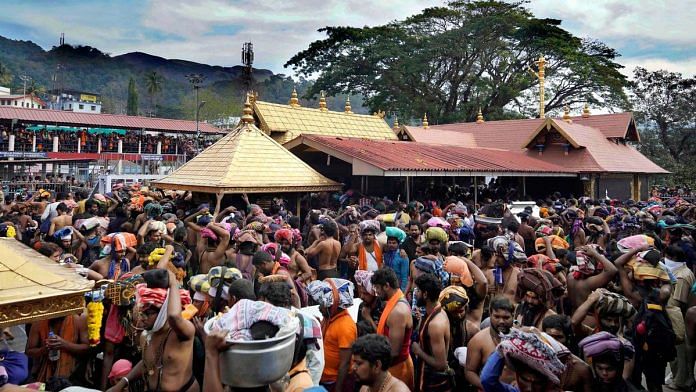A special occasion for the Sabarimala temple, the festival this year comes amid the showdown over women’s entry into the shrine.
Bengaluru: The authorities at Kerala’s Sabarimala shrine will be on full alert Monday, not only because of the continuing protests over the entry of women of all ages into the sanctum sanctorum, but also because the day marks Makara Jyoti, a very special occasion at the temple complex.
Each year, on Makara Jyoti, thousands of devotees throng the Sabarimala temple. As many as 106 people died in a stampede triggered by the flood of devotees in 2011, and 53 in another in 1999.
Makara Jyoti coincides with harvest festivals across the country, such as Pongal and Makar Sankranti. In Hindu religion, it is the day Bhishma chose to finally die on his bed of arrows in the Mahabharata.
Sabarimala’s Makara Vilakku
Each year, the Makara Jyoti sees the lighting of a divine lamp called the Makara Vilakku at Sabarimala.
As devotees gather at the temple in the thousands, a faraway speck of light appears in the mountains.
For centuries, it was believed that the light was divine and some of the faithful continue to believe this even today. However, it is an open secret that, originally, the lamp was lit after the completion of prayers by the tribes living in the area and the practice was continued by the Travancore Devaswom Board (TDB), which runs Sabarimala.
This year, amid the showdown over the Supreme Court’s order allowing women of all ages into the temple, celebrations of Makara Jyoti will keep the administration on its toes.
The celestial significance of Makar Jyoti
The day marks the transition of the Sun from the constellation of Sagittarius (Dhanus) to Capricorn (Makara).
It is the start of the Sun’s six-month journey in the northern direction on the celestial sphere (the map of the full sky as seen from Earth).
The journey of the Sun in the northern direction is called ‘Uttarayana’ and concludes on 14 July, on what is called ‘Karka Sankranti’.
From July to January, the Sun travels among the southern constellations in a journey called ‘Dakshinayana’.
Hindu religion considers ‘Uttarayana’ to be one day and ‘Dakshinayana’ one night for gods.
Sidereal vs tropical
While the celestial event may be of religious significance, it has no scientific significance.
What it shows is the difference between the sidereal and the tropical zodiacs, and the evolution of astrology from two different forms of astronomy.
‘Sidereal’ is a term used in both astrology and astronomy. In astronomy, sidereal time is measured using the Earth’s rate of rotation with respect to stars that are fixed in the sky. One sidereal day is when the same stars are seen in the same parts of the sky: 23 hours, 56 minutes, and 4.09 seconds long.
A solar ‘tropical’ day is when the Sun reaches the same point in the sky. Because the Earth is also moving in orbit around the Sun, the Earth still needs to rotate a little bit more after the completion of one sidereal day to complete one solar day — 24 hours.
Also read: Kolkata scientists develop ground-breaking model to predict solar cycles
Sidereal astrology uses fixed stars as reference points, while ‘tropical’ astrology uses the Sun.
The Earth precesses as it rotates, or wobbles moving its axis, so Makara Jyoti falls in January even though the Sun’s movement in the north starts right after the winter solstice of 21-22 December, when the Earth’s poles are tilted the maximum away from the Sun.

The protests
History was made at Sabarimala on 2 January when two women entered the temple following a Supreme Court ruling last September that women of all ages could enter the temple’s sanctum sanctorum.
Since then, violent protests by those who oppose the ruling have prevented women from gaining access to the temple until Bindu and Kanakadurga, escorted by police, managed an early morning visit.
Also read: These are the groups trying to stop women from entering Sabarimala temple



